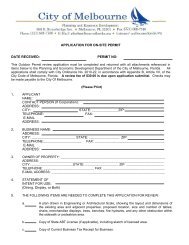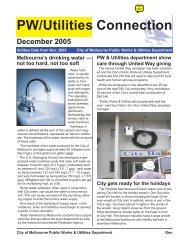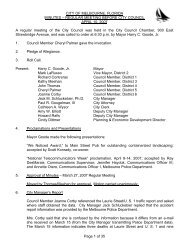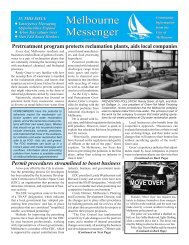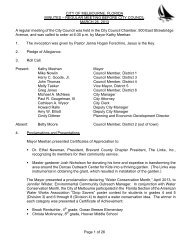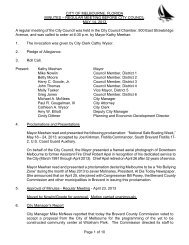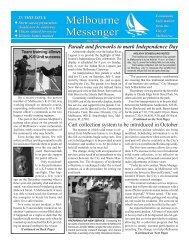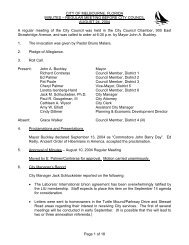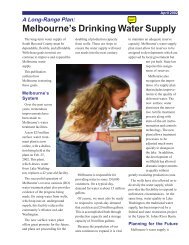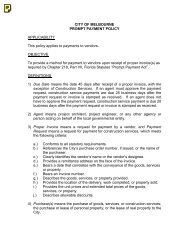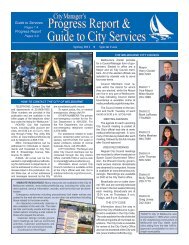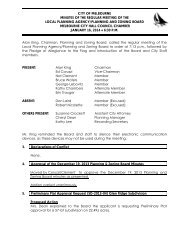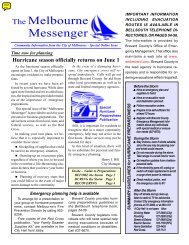Historic Guidelines - City of Melbourne, Florida
Historic Guidelines - City of Melbourne, Florida
Historic Guidelines - City of Melbourne, Florida
You also want an ePaper? Increase the reach of your titles
YUMPU automatically turns print PDFs into web optimized ePapers that Google loves.
INTRODUCTION<br />
<strong>Historic</strong> Setting<br />
The first permanent settler in the Eau Gallie area was John Carroll Houston, who came to<br />
Brevard County in 1859 to clear and homestead an 80-acre community<br />
1. Houston called the settlement<br />
Arlington and built a log cabin house and slave quarters at the mouth <strong>of</strong> Elbow Creek, near the present<br />
day intersection <strong>of</strong> Houston and Young Streets. The region did not experience significant change until<br />
the arrival <strong>of</strong> William Henry Gleason, who acquired about 16,000 acres along the Indian River in 1869.<br />
In the 1870s, the village became a popular stop for boats traveling from Jacksonville to Miami. In 1884,<br />
2<br />
Mr. Gleason filed the Eau Gallie Plat, which laid out the town in an orthogonal grid pattern, and began<br />
selling lots in the new town. Gleason changed the name <strong>of</strong> the town to Eau Gallie (“Rocky Water”) for<br />
3<br />
the abundant coquina rock that lined the shore . Eau Gallie was now becoming a prosperous river town.<br />
The growth <strong>of</strong> Eau Gallie had a boost with the arrival <strong>of</strong> the railroad. Henry Flagler’s <strong>Florida</strong><br />
East Coast Railway arrived in Eau Gallie in 1893 and days later extended to <strong>Melbourne</strong>. Flagler’s tracks<br />
continued their march down the east coast, arriving in Miami in 1896, and to Key West in 1912. The<br />
railroad brought tourists, settlers, and an inestimable boost to the region’s economy, as produce and<br />
timber could now be shipped to out-<strong>of</strong>-state markets. The Town <strong>of</strong> Eau Gallie and the neighboring<br />
“Town <strong>of</strong> <strong>Melbourne</strong>” developed steadily during the 1880s and first half <strong>of</strong> the 1890s. In 1895, a<br />
devastating freeze destroyed most <strong>of</strong> the local citrus groves.<br />
As replanted groves began to bear fruit, the village experienced a second period <strong>of</strong><br />
development. Commercial fishing, truck farming, and tourism played significant roles in the<br />
diversification <strong>of</strong> the local economy. That era <strong>of</strong> expansion closed in 1917 when the US entered World<br />
4<br />
War I.<br />
DRAFT<br />
William Henry Gleason<br />
<strong>Florida</strong> East Coast Railroad<br />
3<br />
1<br />
2<br />
3<br />
4<br />
Cleveland, Weona. Genealogical Society <strong>of</strong> South Brevard: Olde History <strong>of</strong> <strong>Melbourne</strong>.<br />
Olausen,Stephen. <strong>Historic</strong> Buildings <strong>of</strong> <strong>Melbourne</strong>. 1991, 9<br />
Karen Raley and Ann Raley Flotte, Images <strong>of</strong> America: <strong>Melbourne</strong> and Eau Gallie; Arcadia Publishing, 2002<br />
<strong>Historic</strong> Property Associates, Inc. Cultural Resource Survey <strong>of</strong> <strong>Melbourne</strong>, <strong>Florida</strong>. 1991



